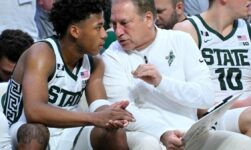Conference realignment is generally thought of as a football-oriented process that will be occurring in the coming years, as the AAC, Big 12, Big Ten, Pac-12 and SEC are all set for significant changes within their memberships. But significant realignment is coming in college basketball as well, and some of it is happening sooner than you might think.
When the 2022-23 season tips off in November, there will be 24 teams in new Division I conferences as the winds of change in college sports continue to blow. We already broke down the entire list of this year’s changes and the future conference moves in July, but now it’s time to break down what this season’s changes could mean on the court in the years to come.
With five schools making their Division I debuts and solid leagues like the Atlantic 10 and Missouri Valley Conference undergoing big changes, there could be some intriguing new battles for automatic NCAA Tournament bids shaping up in the months ahead. So for this week’s edition of the Dribble Handoff, our writers are evaluating which teams are set to have the biggest impact on their new conference beginning in the 2022-23 season.
Murray State
The Missouri Valley Conference losing Loyola Chicago — a recent Final Four participant — to the Atlantic 10 wasn’t ideal, but the league reacted strongly by adding a proud and great basketball program in Murray State. The Racers have made three of the past four NCAA Tournaments and been in eight NCAA Tournaments this century with five different head coaches, which is always a sign of a program with a strong foundation. When basically every coach hired for a significant stretch of time succeeds, it’s no accident. On that note, consider that the last Murray State coach who didn’t take the school to the NCAA Tournament at least once is Ron Greene, whose final game with the Racers was in 1985.
That’s incredible.
There’s no real reason to think Murray State’s transition to the MVC will be anything but smooth, at least from a longterm perspective, even with Matt McMahon leaving for LSU after last season. That’s because his replacement is Steve Prohm, who preceded McMahon and guided the Racers to two conference championships, one NCAA Tournament and a top-10 ranking. He knows what success at Murray State looks like, and that’s why I expect Prohm to keep the Racers in contention for NCAA Tournament berths nearly annually in the MVC, which was a two-bid league as recently as two seasons ago. — Gary Parrish
Loyola Chicago
The Atlantic 10 is now a 15-school league. That’s too many for a conference that has averaged just 2.5 NCAA Tournament bids over the past eight seasons. But if the A-10 was going to add one more team to strengthen its national profile, it went the best route by linking up with Loyola Chicago. The Ramblers are an upgrade not just because of their recent success (making a Final Four is a significant boost to the résumé; the school also claims a 1963 national championship), but by being in the Chicago market, the league will help its recruiting footprint and media reach. If Drew Valentine — who’s entering his second season as head coach — can keep this program on a steady trajectory, LUC should be able to settle in as a top-six program in that conference in the next half-decade.
The league did this before, a decade ago, when it welcomed in Butler fresh off back-to-back Final Four appearances. That turned out to be short-lived, as BU got the Big East call-up once nationwide realignment prompted the dissolution of the old Big East. I don’t think that’s the course here for LUC, which has the resources, location and institutional fit to strengthen the A-10, provided the right coach is in place. With Valentine there, it all lines up. The Ramblers are an ideal fit for the Atlantic 10, and I’d imagine, a long-term member. — Matt Norlander
Bryant
Jared Grasso took over a stinker of a program at Bryant that was a shambles at the end of the Tim O’Shea era and quickly transformed it into a power in the NEC, culminating with a league regular-season and postseason title and its first-ever NCAA Tournament appearance earlier this year. The transition to the America East couldn’t come at a better time for the Bulldogs as they continue to build a stable and consistent winner under Grasso.
Losing First Team All-Confidence superstar Peter Kiss, the leading scorer last season in college hoops and a First Team All-NEC standout, won’t make the transition as easy as it could have been had Bryant integrated into the new conference a year ago. Still, this program looks like it’ll be retooling and not rebuilding. It added four high-level transfers, led by NCAA Tournament star Doug Edert from Saint Peter’s, Memphis transfer Earl Timberlake and Rhode Island transfer Antwan Walker, all of whom have extensive experience at the Division I level.
The America East runs through Vermont until further notice — it has won six straight regular season conference championships — but the Catamounts are on notice in a new league landscape with Bryant on the way. With an up-and-coming coach in Grasso and a proven returning scorer in Charles Pride buttressing an experienced transfer class, the Bulldogs can be a big winner in the AE just like they were in their final days with the NEC. — Kyle Boone
Southern Indiana
Murray State and Belmont have won or shared the OVC regular-season title each of the past 13 seasons. Over the past 20 seasons, those two and Austin Peay have won the league 18 times. In terms of postseason success, one of those three have won the conference’s tournament — and thus claimed its automatic NCAA Tournament bid — 13 of the past 20 seasons. So where does the league go from here now that three of its best programs are gone?
Coming off consecutive 20-win seasons and a 2021 NCAA Tournament appearance, Morehead State could be poised to emerge as the league’s top brand. But Southern Indiana will have a great chance to enter and immediately flex its muscles as a historically proud Division II program as well. Even though they won’t be eligible for the NCAA Tournament until 2027, the Screaming Eagles could wreak havoc on the OVC immediately. USI won the 1995 Division II national title under Bruce Pearl and made its fourth Final Four appearance in 2019. In the three seasons since, it is 52-21 at the Division II level and could be poised to copy the blueprint offered by one of its former conference rivals.
Bellarmine, which boasted a similarly proud Division II legacy in the Great Lakes Valley Conference, managed to win the Atlantic Sun Conference Tournament last season in just its second full season at the Division I level. With a 34-21 (21-8 Atlantic Sun) record in two seasons since moving up, the Knights have already become a force in their new league. Given Southern Indiana’s similarly strong history and the weakened state of the OVC, the bet here is that USI quickly fills the success vacuum left behind by the departing members of its new conference. — David Cobb




